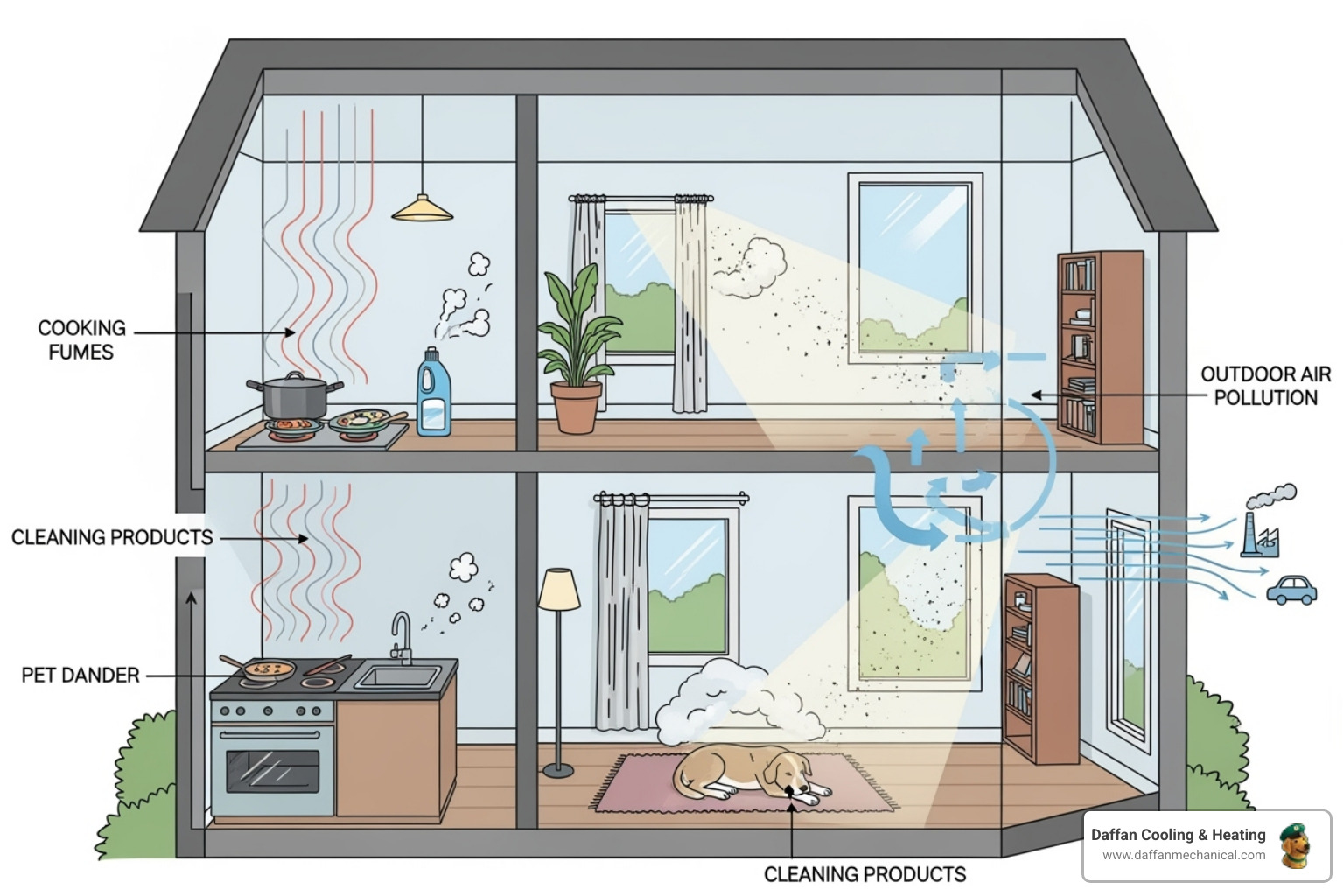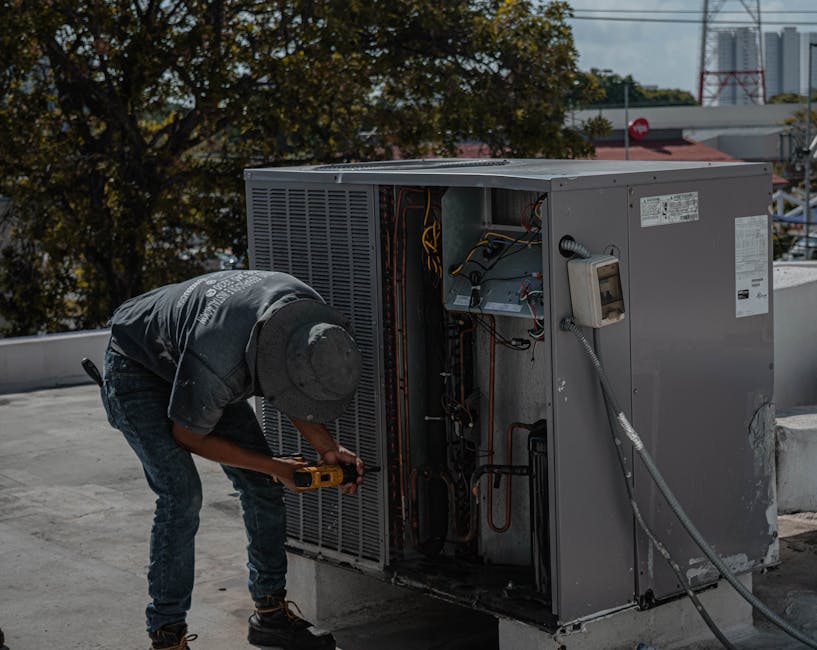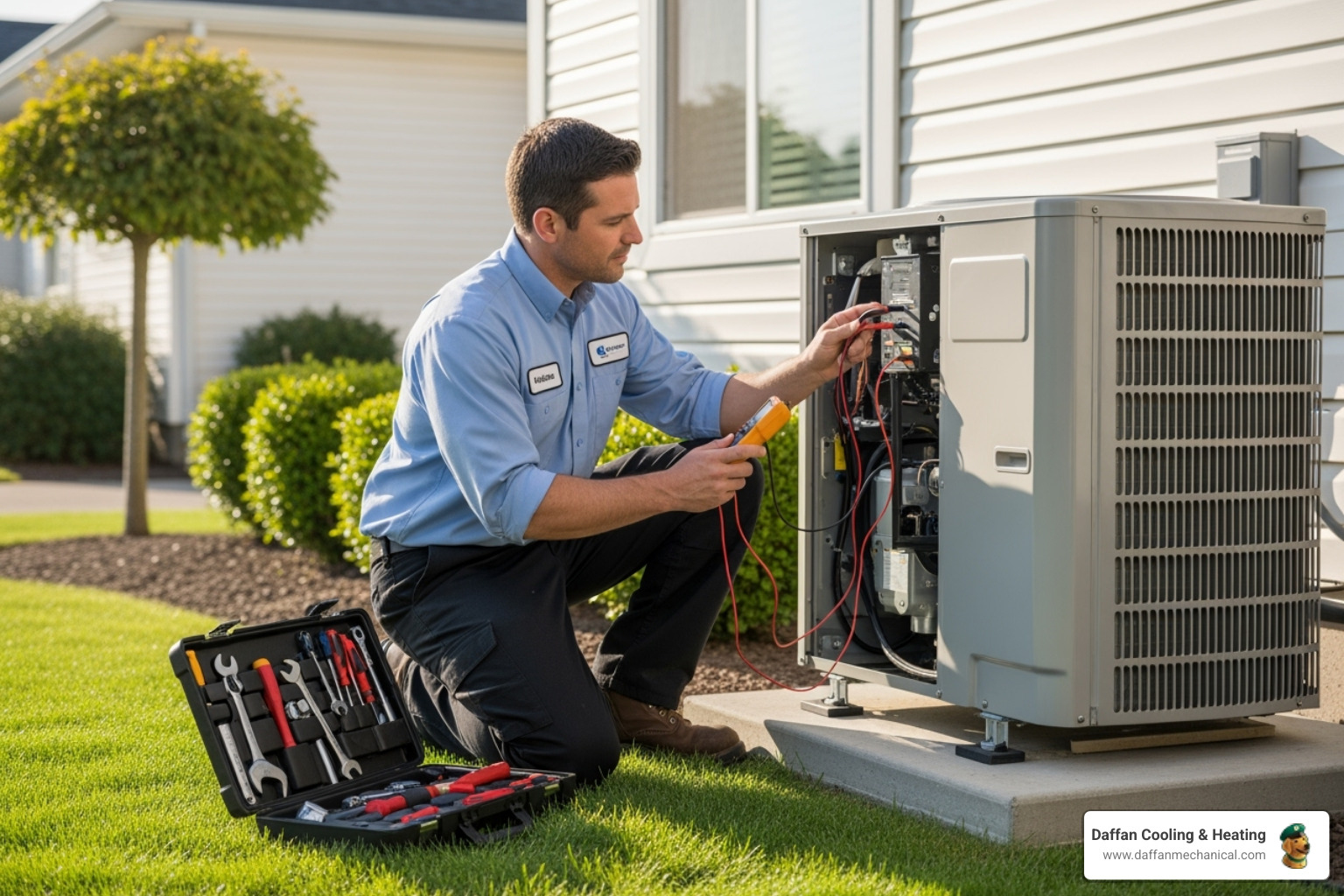Introduction: Why Your Home’s Air Matters More Than You Think
Indoor air quality Granbury TX is a critical concern, as the EPA reports that indoor air can be 2 to 5 times more polluted than outdoor air. Since most people spend about 90% of their time indoors, the air at home can significantly impact health.
Quick Answer: Indoor Air Quality in Granbury TX
- Main pollutants: Dust, pollen, pet dander, mold, VOCs, and biological contaminants
- Common symptoms: Allergies, headaches, fatigue, respiratory issues, lingering odors
- Primary solutions: Regular HVAC maintenance, air filter replacement, air purifiers, dehumidifiers, duct cleaning
- Testing options: Professional IAQ assessment or DIY test kits for specific pollutants
- Key factor: Your HVAC system plays a central role in circulating and filtering indoor air
In Granbury, our homes face unique challenges. The Texas climate’s high humidity encourages mold growth, while dust settles inside. Modern, energy-efficient homes are great for utility bills but can trap these pollutants without proper ventilation.
The good news is that you have significant control over your indoor air. Your HVAC system is more than just a heater or cooler; it’s the lung system of your home, constantly circulating and filtering the air your family breathes. Understanding what affects your indoor air quality is the first step toward creating a healthier home. This guide will help you identify problems and find practical solutions.
Recognizing the Unseen: Signs and Health Impacts of Poor Indoor Air
Poor indoor air quality Granbury TX often reveals itself through subtle signs. You might blame allergies, fatigue, or lingering headaches on other causes, but your home’s air could be the culprit. Visible clues include persistent dust, musty odors, or dark spots indicating mold growth.
The U.S. Environmental Protection Agency has found that indoor air can be two to five times more polluted than outdoor air. Since we spend about 90% of our time indoors, improving air quality is essential for your family’s health. Our guide on 5 Indoor Air Tips for Better Health offers practical steps you can take today.
Common Symptoms You Shouldn’t Ignore
Your body often signals a problem with indoor air, but the symptoms can be mistaken for other health issues. Pay attention if these issues are more frequent at home:
- Persistent coughing and sneezing: Your respiratory system reacting to airborne irritants like dust, pollen, or mold spores.
- Headaches and dizziness: Can indicate poor ventilation or the presence of harmful gases like carbon monoxide.
- Scratchy throat and nasal congestion: Often caused by chronic inflammation from irritants like dust mites or chemical fumes.
- Unexplained fatigue: Poor air quality can reduce oxygen levels and introduce toxins, draining your energy.
- Irritation in eyes, nose, and throat: A direct response to particles and pollutants in the air.
When these symptoms become a daily reality, they diminish your quality of life. Your home is trying to get your attention.
Long-Term Health Risks of Polluted Indoor Air
The real danger of poor air quality lies in long-term exposure. The US Environmental Protection Agency has documented serious health consequences from breathing polluted indoor air over time.
For those with asthma, indoor pollutants like mold, dust mites, and pet dander can trigger attacks and worsen the condition. Constant irritation can lead to chronic bronchitis and other lung diseases.
Your heart is also at risk. Fine particulate matter (PM2.5) can enter the bloodstream, contributing to inflammation and increasing the risk of heart disease.
Biological contaminants like bacteria and viruses thrive in poorly ventilated spaces, increasing the risk of infection. Some pollutants, like certain VOCs, can even affect your brain and nervous system, impairing cognitive function and memory.
Most frightening are the cancer risks from pollutants like radon and formaldehyde, which are known carcinogens. Long-term exposure significantly raises the risk of developing cancers, especially lung cancer.
Children and the elderly are most vulnerable. Children breathe more air relative to their body size, and seniors may have pre-existing conditions. Protecting your family’s indoor air quality Granbury TX is about safeguarding everyone’s long-term health.
The Culprits Within: Common Pollutants in Granbury Homes
To improve your home’s air, you first need to know what you’re up against. Pollutants in Granbury homes generally fall into a few categories: particulates (dust, pollen), biological contaminants (mold, bacteria), Volatile Organic Compounds (VOCs) from household products, and harmful gases like carbon monoxide.
Once you identify the culprits, you can take targeted action. For a deeper dive, see our guide on Common Indoor Air Pollutants.
Biological Contaminants Fueled by Texas Humidity
The thick, heavy humidity in Texas is a breeding ground for unwanted biological guests in your home.
- Mold and mildew thrive in damp, warm conditions created by leaks or high indoor humidity. They release spores that trigger allergies and respiratory issues. A musty smell is a key warning sign.
- Bacteria and viruses travel on dust and moisture droplets, circulating through your home’s air and increasing the chance of illness, especially without proper ventilation.
- Dust mites are microscopic pests that flourish in warm, humid environments like bedding and carpets. Their waste is a major trigger for asthma and allergies.
Controlling humidity is your best defense. Whole-house dehumidifiers are designed for Granbury’s climate, making your home inhospitable to these invaders. Find out how we can help you Improve IAQ with Whole House Dehumidifiers.
Chemicals and Gases Hiding in Plain Sight
Invisible chemical pollutants can quietly degrade your indoor air quality Granbury TX, often originating from everyday items.
- Volatile Organic Compounds (VOCs) are gases released from products like cleaners, paints, new furniture, and building materials. This “off-gassing” can cause irritation and other health effects.
- Formaldehyde, a specific VOC found in pressed-wood products and glues, is a known irritant and carcinogen.
- Carbon monoxide (CO) is an odorless, colorless, and deadly gas produced by the incomplete burning of fuel. Faulty furnaces, gas stoves, and water heaters are potential sources. Working CO detectors are essential for safety. For more information, see our resource on Information on Carbon Monoxide Safety.
- Radon is a naturally occurring radioactive gas that can seep into homes through cracks in the foundation. It is the second leading cause of lung cancer, making testing a wise precaution.
Proper ventilation and regular maintenance of fuel-burning appliances are crucial for mitigating the risks from these hidden chemicals.
Your HVAC System: The Lungs of Your Home and Key to Better Air
Your HVAC system functions like your home’s lungs, drawing in air, filtering it, and circulating it through every room. A well-maintained system is your greatest ally for good indoor air quality Granbury TX, capturing pollutants and controlling humidity. A neglected one, however, can spread dust and allergens.
The system’s constant air movement prevents staleness and pollutant buildup. It also plays a key role in dehumidification, which is vital in our Texas climate. Furthermore, leaky ductwork can pull in contaminants from attics or crawl spaces, bypassing filters entirely. This makes regular maintenance and duct integrity crucial for clean air. We cover this topic in more depth in our article About Indoor Air Quality in Homes.
The First Line of Defense: Air Filters and MERV Ratings
Your air filter is the first barrier against airborne particles. It traps dust, pollen, and pet dander, protecting both your health and your HVAC equipment. Filters are not all the same, which is why MERV ratings (Minimum Efficiency Reporting Value) are important. A higher MERV number means the filter can trap smaller particles.
- MERV 1-4: Basic filters that protect equipment.
- MERV 5-8: Good for most homes, capturing mold spores and pet dander.
- MERV 9-12: Ideal for homes with allergy sufferers, capturing finer particles.
- MERV 13+: High-efficiency filters that can trap bacteria and viruses, but require a compatible HVAC system to handle the restricted airflow.
According to the EPA, filters with MERV 7-13 are highly effective for most indoor particles. It’s critical to choose a filter your system can handle and to change it every 1-3 months. This simple step is a huge win for better indoor air quality Granbury TX. For more tips, see our 4 Tips for Improved Air Quality.
Beyond Filters: Advanced Solutions for Superior Indoor Air Quality in Granbury TX
For comprehensive air cleaning, advanced whole-home solutions work with your HVAC system to tackle what standard filters miss.
- Whole-home air purifiers integrate into your ductwork to neutralize microscopic particles, allergens, bacteria, viruses, and odors throughout your entire home. Explore our Air Purifiers Granbury TX options.
- UV light sanitizers are installed inside your HVAC system to destroy the DNA of microorganisms like mold and bacteria, cleaning the air and preventing growth on the damp evaporator coil.
- Whole-house dehumidifiers provide precise moisture control, which is a game-changer in Granbury. Keeping humidity between 30-50% makes your home inhospitable to mold and dust mites. Learn about our Dehumidifiers Granbury TX solutions.
- Energy Recovery Ventilators (ERVs) bring in fresh outdoor air while exhausting stale indoor air, all without wasting energy. They are perfect for modern, tightly sealed homes that need better ventilation.
These solutions can transform your home’s air. Our team can help determine the most effective options for your specific needs.
Frequently Asked Questions about Indoor Air Quality in Granbury TX
Navigating indoor air quality can bring up many questions. Here are answers to some of the most common ones we hear from Granbury families.
How can I test the air quality in my Granbury home?
Since most pollutants are invisible, testing is the best first step. You have two main options for testing your indoor air quality Granbury TX:
- DIY Test Kits: Available at hardware stores or online, these kits can test for specific pollutants like radon, mold, or VOCs. They are a good starting point if you have a particular concern.
- Professional IAQ Assessment: For a complete picture, a professional assessment is the way to go. Our certified technicians use specialized equipment to measure a wide range of pollutants, check humidity, and assess ventilation. We provide a comprehensive analysis and specific, actionable recommendations custom to your home. To get started, visit our Air Quality Testing Granbury TX page.
How often should I have my air ducts cleaned?
The National Air Duct Cleaners Association (NADCA) recommends cleaning ducts on an as-needed basis, but a general guideline is every 3 to 5 years. However, you should consider more frequent cleaning if you:
- Have pets that shed.
- Have family members with allergies or asthma.
- Have smokers in the home.
- Have recently completed home renovations.
- Notice visible mold growth or excessive dust.
Clean ducts improve air quality and help your HVAC system run more efficiently. For more details, see the NADCA recommendations.
What is the current outdoor air quality in Granbury and how does it affect my home?
Outdoor and indoor air are closely linked, as pollutants from outside can easily infiltrate your home. Granbury’s outdoor air quality is generally good, but it’s still important to be aware of factors like PM2.5 (fine particulate matter) and ozone. You can check the Live Granbury Air Quality Data for real-time information.
Outdoor pollutants sneak in through tiny cracks and gaps. On days with good air quality, opening windows is a great way to ventilate. However, when pollen counts are high or there’s a spike in pollution (from dust, smoke, etc.), it’s better to keep windows closed and rely on your HVAC system’s filtration.
Regional factors, like wind-blown dust from agricultural areas, can also temporarily affect our air. Our goal is to help you create a healthy indoor sanctuary, no matter what’s happening outside, by managing the interaction between indoor and outdoor air to maintain optimal indoor air quality Granbury TX.
Take Control of Your Home’s Air Today
We’ve uncovered the hidden world of indoor air quality Granbury TX, from invisible pollutants to the solutions that defeat them. The air in your home is constantly shaping your family’s health and well-being, and the good news is that you have the power to improve it.
Taking proactive steps is an investment in your family’s future. It means improved health with fewer allergy flare-ups and respiratory issues, improved comfort in a home free from musty odors and humidity, and the peace of mind that comes from knowing your loved ones are breathing clean, safe air. As a bonus, a clean HVAC system runs more efficiently, lowering energy bills.
Your HVAC system is the hero in this story, but it needs support. Upgrades like a whole-home air purifier, a dehumidifier for our Texas climate, or professional duct cleaning can make all the difference.
At Daffan Cooling & Heating, our reputation is built on Christian values and a commitment to serving our Granbury neighbors. Our skilled technicians provide expert care to solve your specific indoor air quality challenges and help you create the healthiest home environment possible.
Don’t settle for poor air quality. Better air is within reach, and we’re here to help. Take the first step today for your family’s health.









